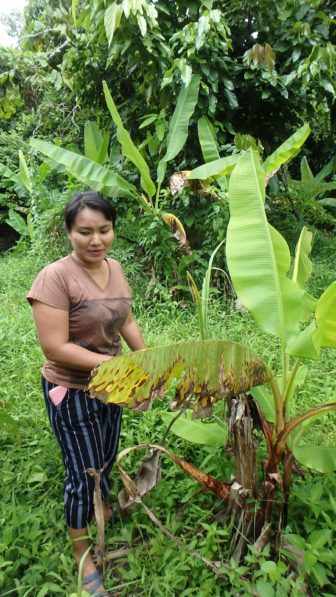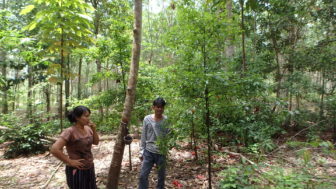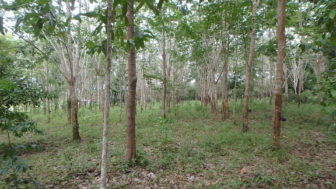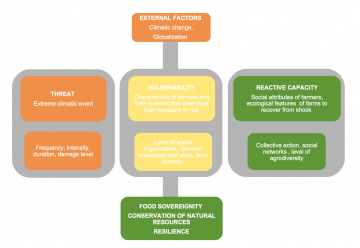Date Published: January 11, 2018 | Author: Michael B. Commons
In my collaboration with Terra Genesis International, I have been given space and support to investigate what we may call “Regenerative Pathways” looking at real life examples of functional farming systems that we can identify as being on the “Regenerative Agriculture Pathway.”
While these farms/farming systems might be called “Regenerative Farms,” we see regeneration more as a long term process and continuum that we can evaluate through indicators such as soil health, water retention, biodiversity, community health and more.
Of particular interest for us is to look at farms/ systems that are producing “key economic crops” as so much of our land area is now dominated by “economic crops” and these crops’ link to larger trade systems. With such a link there is the possibility to develop collaborative relationships to support regenerative practices and systems between farmers, consumers and intermediaries.
My wife and I, for many years, have been active members of the Thai Wanakaset (Agroforestry and Self-Reliance) network, which has a number of farmer members who live at the edges of natural forest reserves with wild elephant populations. For most Thais in this situation, as well as farmers with whom I have spoken from Sri Lanka and Bhutan, this relationship and interaction is much more confrontational.
Generally, forest and wild areas are being reduced and transformed into farming monocultures, while the Thai wild elephant population is actually increasing seven percent a year, according to a recent Thai PBS article.
From my own observations living in this area around the Eastern Forest of Thailand, most all of the small marginal wild areas that served many species of wildlife have been removed in the last decade (converted to farmland or other uses). Therefore, the elephants are increasingly going out of the preserves and national parks to farms for food.
From what I have learned talking with those who live in and around the elephants, these four-legged beings are incredibly intelligent and adept learners, so they have learned and adapted to eat many new foods, like pineapples, corn and rice. My colleagues have told me that elephants can choose to politely harvest from fields rather than to destroy them. Yet for most Thai farmers, they don’t accept any such sharing of their harvest. Thus, the greater focus has been on converting to crops that elephants don’t like to eat, or using measures to prevent their entry or scare them away.

Kanya shows banana trees next to her home that they have planted for the elephants. If the elephants are courageous to show themselves so close they can enjoy the banana stalks- which is what usually happens. Photo Credit: Michael B. Commons.
The Wanakaset members of Pawa subdistrict, Chantaburi, have taken a very different path. They have developed diverse forest garden systems that allow space and place for wild elephants. Their farm environments have many different plants that the elephants can eat without needing to take or destroy the family’s key crops. The stories these farmers tell are also quite amazing and inspiring. It seems that the elephants are completely aware of what the forest gardeners are doing and the lands they manage. They hold this coexistence in regard, coming regularly into these shared spaces and largely respecting the crops the humans ask to be left alone, while they enjoy other crops and places provided for them.
In my deeper vision of “Regeneration,” I believe we need to heal the divide between humans and non-humans, and that humans can be stewards of lush gardens that provide valuable yields for humans and food and habitat for other living beings. As elephants are such a key species with great power, including the power to destroy, that we can find examples of a peaceful, balanced co-existence, gives much hope.
Thus I decided to embark on a journey to learn more from my farmer colleague, Ms. Kanya Duchita, to understand and share with others.
Kanya Duchita and her parents are students of Pooyai Viboon and practitioners of “Wanakaset,” the philosophy and system of organic agroforestry and self-reliance that he taught. Wanakaset, like permaculture, is a design system that reflects the land, situation, needs, skills and interests of the people involved. The process should arrive at some form of an integrated forest garden system that meets the needs and interests of the farmer/gardeners who live in it and who guide its evolution. The land and climate of Pawa are favorable for wet tropical fruits (durian, mangosteen, langsat, rambutan) and rubber. Kanya’s family land sits very close to Khao Chamao National Park, a healthy forest with a large number of resident wild elephants.
Michael Commons (MC): “Kanya you once told me that you practice Wanakaset because you are a lazy person. Can you really be lazy and practice Wanakaset (forest gardening)?
Kanya Duchita (KD): “The work of Wanakaset is light work all of the time, compared to conventional farmers who need to work very hard in periods, having to rush to complete their work. As forest gardeners we just need to do some light work and observation all of the time.”
“As we work a bit all of the time, you might say we are not lazy, and we can choose to do more management and get better yields and returns, but at the same time our trees take care of themselves. If we just leave them alone they will be fine and we will still be able to harvest from them.”
“We also have many diverse resources in our forest gardens during the whole year. Herbs such as bamboo grass (for heavy metal detoxification), Chamuang leaf (Garcinia cowa for heart disease and weight loss), we can harvest and process any time. That is, if we want to spend the time to harvest and process them. Even with fruits which are seasonal, we can sell fresh, but also process them for more value.”

A Mapram (Garcinia species) growing to the right of a productive rubber tree. This medicinal fruit tree came naturally once this rubber plantation was allowed to become a rubber forest. Photo Credit: Michael B. Commons.
MC: “As I see most tropical fruit orchards are integrated and have durian, mangosteen, langsat, and rambutan, how does your garden differ?”
KD: “As forest gardens we integrate more, like fiddle head ferns, pak wan pa (Melientha suavis) and different types of gingers and herbs that can live under the shade of these trees. We also plant pepper vines (black and long pepper) to directly climb up our trees. Most farmers would plant these separately, but we just let them grow up our trees and don’t provide any other care. This is methodology derived from laziness.”
“Most fruit gardeners don’t like to have other trees around their durian trees as it can make harvesting (catching) the durian difficult. But we have observed that with this mix the soil quality is better and holds moisture much longer—meaning in dry season we need to water much less than conventional farmers, and when tropical windstorms come through we don’t lose branches from our durian trees.”
“Wild elephants are a big part of the reason we choose to practice forest gardening, if we only grow fruits (that we harvest and sell), then the elephants often come and eat this fruit and damage the trees. But in our very integrated system, we have many other trees with foods that elephants also enjoy to eat at the edges of our land, like bamboo and fishtail palms, which we do not mind at all if they eat. We have learned a lot from experience what is the best way to garden that can work for us and the elephants who are our neighbors and also come into our gardens.”
MC: “You grow rubber as well, which we normally see only as a monoculture, but you have it in a very integrated garden system, does this affect yields?”
KD: “The yield (in rubber) per tree is not really different than in chemical plantations, but very different in terms of costs (much lower). In transitioning (to organic) we used manure for four or five years but since then did not need any fertilizer at all. Many older wild plants and trees came back after we stopped using herbicide. This includes wild vegetables, wild fruits, herbs and hardwoods. These produce valuable yields for us on top of the rubber. Now we are expanding our focus and cultivation of Mapram—a wild forest fruit related to mangosteen—which does very well in the shade of the rubber and is increasingly valued. (probably Garcinia hombroniana)”
“So in some cases we have allowed the forest to come back under our rubber plantations—now rubber forests—but we also have planted rubber along with other species in integration from the start: sator beans (Parkia speciosa), boon nak, jantana (wood used for incense), dipterocarpus and ginger species, in between the rows of rubbers. In this case the rubber production is good for the whole year except for a break in the driest months, and then we have other valuable yields, such as sator-tree beans. My older brother also harvests many seeds for propagation as seedling trees to sell. The rubber yield is as good as others obtain with no use at all of fertilizer (including organic fertilizers beyond the first years). This rubber forest is still organized in rows and easy to enter and harvest.”

A section of rubber integrated into a fruit and herb forest. Photo Credit: Michael B. Commons.
MC: “How about native biodiversity and wildlife?”
KD: “All three of our gardens have good edible mushrooms growing with them, mycorrhizal and termite mushrooms. There are many birds everywhere and of many different species. These birds also help us in propagation—they have seeded rattan and pak wan (a delicious edible perennial vegetable) all around and brought some unusual varieties to our garden from afar. We also have many squirrels who do eat and sometimes damage our fruits. While many other gardeners shoot squirrels, we just leave damaged and unattractive fruit for them on the trees.”
MC: “What about snakes as I have heard many rubber growers say that snakes are a threat harvesting in the very early morning?”
KD: “While snakes can be scary, I don’t really feel we have more snakes, and maybe even less problem as it seems they have their own space to live and be apart from humans (in our garden) and don’t bother us.”
With Kanya, we see three gardens types showing three different pathways to integration.
- Fruit forest, with rubber and herbs. This was their existing tropical fruit orchard—still with strong valuable productive fruit trees like durian. In some areas, they then added rubber trees into this mix as well bringing in and allowing many smaller herbs, vines and more to be under, on and around the trees. While there is ample space for access (and even to allow elephants through) the rubber is not at all in rows and the feel is like a mature forest.
- Rubber forest: Let the rubber plantation evolve into a rubber forest—allow herbs, wild fruits and trees to come back. This seems like the easiest path towards regeneration, allowing Mother Nature and her helpers to take to the task. It is clear from what Kanya explained that there are seed and root reserves under and around always, so just by stopping the use of herbicide and allowing the forest to come back, it will. Birds also clearly play a key role in propagation. Then the gardener just manages to allow and support what comes, and removes what is not convenient or of particular interest or ready to be harvested.
- Strip intercropping: Plant rubber trees in rows (7-8 meters between rows—according to best practices such a distance is needed for good production in any case—being closer creates too much competition between the rubber trees and less yields) and in between plant a row of different forest and fruit trees that do well in a garden forest environment and provide yields that the farmer/gardener knows how to use. This seems like the best path if starting fresh, however; Kanya and her family have developed a lot of knowledge and experience both in what grows well together, and in the different uses of many different species of trees, fruits and herbs. While the Duchita family shares their knowledge freely and encourages other to practice forest gardening, even someone without such contacts and with little experience can try and plant different trees and herbs that are interesting and may do well, but then observe, learn and evolve (with) his/ her forest garden over time.
From an economic basis, this system wins on many levels: less cost, less work, no less yield in the key economic crops (rubber and tropical fruits), and far greater diversity of total yields. While there are many other indicators, just the peaceful co-existence of the wild elephants in these forest gardens is proof of their ecological success. Most farmers do not appear to be prepared to accept living in and around diverse forest systems with wildlife; adoption is quite low. However, the third method explained above could be easier to accept and adopt for someone who wants an organized and orderly system.
Another Wanakaset farmer who lives not too far away, Ms. Kamolpatara Kasikrom, explained to me more about elephant behavior. She said that resident elephants are territorial and spread out to different areas to feed. For a given territory, about one to three elephants will manage and eat from it. It seems clear that the forest gardens are considered by the elephants to be part of their managed territory, whereas most all farms where humans try to keep elephants out are not part of their territory. The greatest damage from elephants can come when a large herd transmigrates. Resident elephants will protect their territories from such herds and the damage they can bring. No such protection is offered to an unfriendly parcel. While elephants are exceptionally intelligent beings, I believe this may touch to the very core of both our problem and the solution. Here we see that if we consider our land not to be exclusively ours, but also to belong to the many other lifeforms, and we manage it accordingly, these other beings will come to hold the same vision and practice, also working to manage the land for sustainable health and productivity.
***
About the author:
Michael B. Commons lives with his family in Chachoengsao, Thailand where they practice Wanakaset (forest gardening and self-reliance) and are active in the Wanaksaet Network. For over twelve years he has worked with Earth Net Foundation to support small-scale farmer groups and associated supporting organizations from South and Southeast Asia to develop organic and fair trade supply chains, regenerate ecological and community health, and build their resilience capacity. Two years ago he joined Terra Genesis International to use his skills to help link and assist concerned and innovative companies, their consumer networks and farmers’ groups to collaborate in developing regenerative pathways together.




